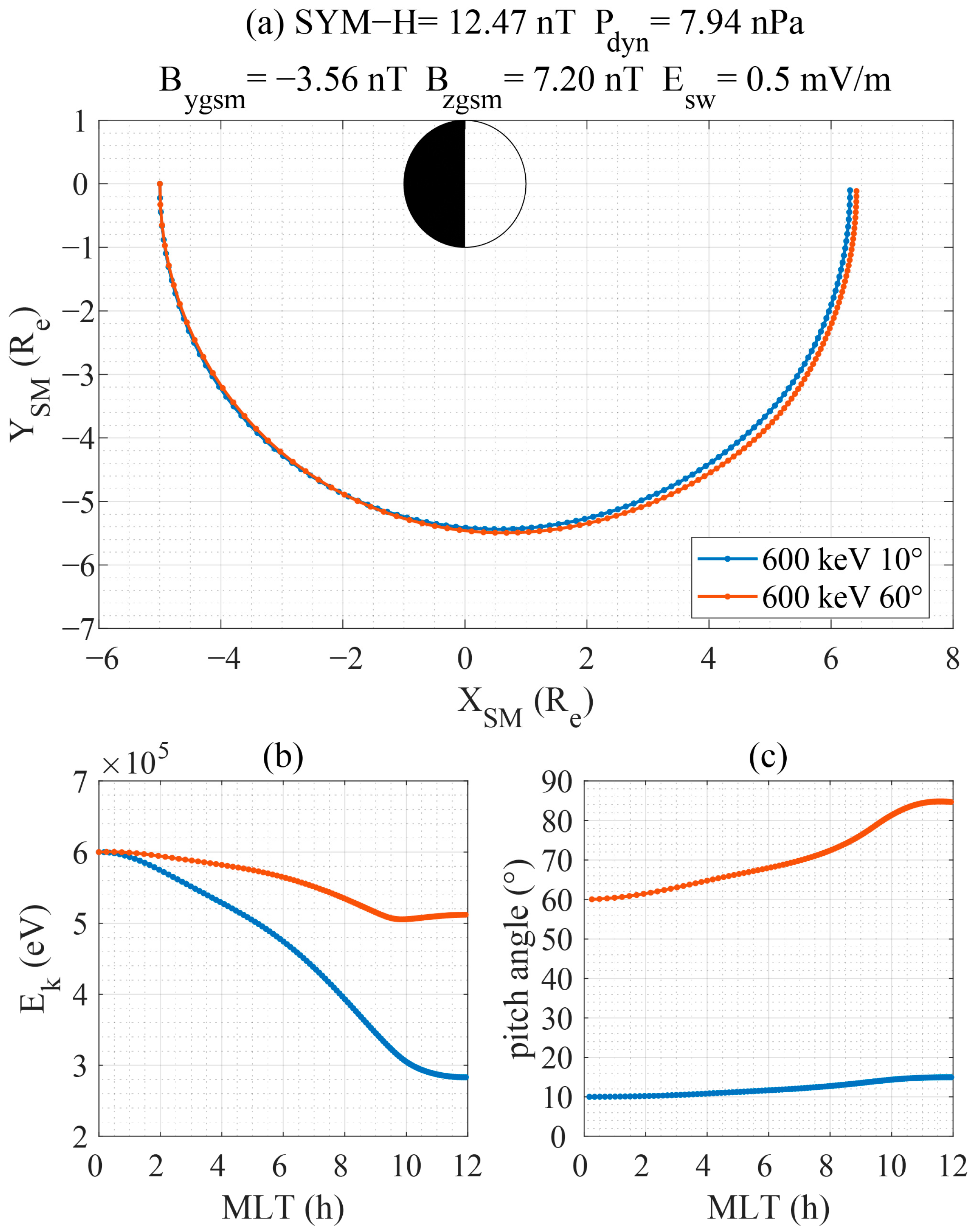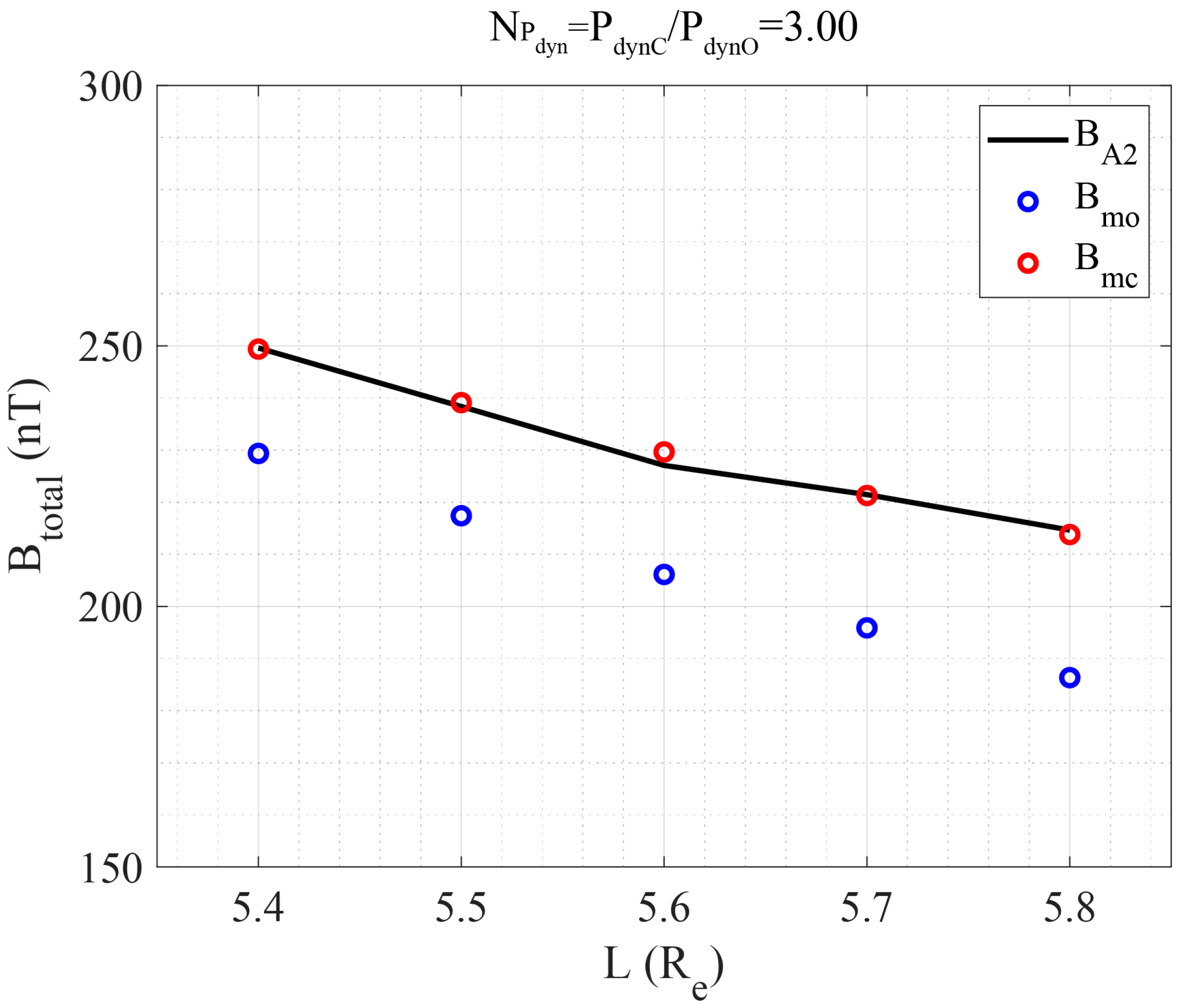The Phase Space Density Evolution of Radiation Belt Electrons under the Action of Solar Wind Dynamic Pressure
Abstract
:1. Introduction
2. Data and Methods
2.1. Instrument and Data
2.2. Event Observations
2.3. The Method of Test Particle Simulation
3. Results
4. Discussion
5. Conclusions
- The electron PSD in the outer radiation belt is sensitive to the change of the geomagnetic field structure, which is controlled by solar wind. The RBSP-A observations on 16:20 UT 19 December 2015 demonstrate that the sharp increase of Pdyn leads to the electron flux in the energy range of 464–901 keV enhance by about 0.3 orders of magnitude within 10 min;
- Under the action of medium Pdyn enhancement (~8 nPa), the electron PSD at high PAs and the energetic electron AT obviously increases. The increase is more obvious for electrons with higher energy levels;
- Under the action of very intense Pdyn (~22 nPa), the electron PSD at all energy and PAs reduce. The anisotropy also decreases by about 0.25, which is related to the magnetopause shadowing effect.
Author Contributions
Funding
Data Availability Statement
Acknowledgments
Conflicts of Interest
References
- Van Allen, J.A.; Frank, L.A. Radiation around the Earth to a radial distance of 107,400 km. Nature 1959, 183, 430–434. [Google Scholar] [CrossRef]
- Baker, D.N.; Jaynes, A.N.; Li, X.; Henderson, M.G.; Kanekal, S.G.; Reeves, G.D.; Spence, H.E.; Claudepierre, S.G.; Fennell, J.F.; Hudson, M.K.; et al. Gradual diffusion and punctuated phase space density enhancements of highly relativistic electrons: Van Allen Probes observations. Geophys. Res. Lett. 2014, 41, 1351–1358. [Google Scholar] [CrossRef]
- Horne, R.B.; Lam, M.M.; Green, J.C. Energetic electron precipitation from the outer radiation belt during geomagnetic storms. Geophys. Res. Lett. 2009, 36. [Google Scholar] [CrossRef]
- Rodger, C.J.; Clilverd, M.A.; Seppälä, A.; Thomson, N.R.; Gamble, R.J.; Parrot, M.; Sauvaud, J.-A.; Ulich, T. Radiation belt electron precipitation due to geomagnetic storms: Significance to middle atmosphere ozone chemistry. J. Geophys. Res. Space Phys. 2010, 115. [Google Scholar] [CrossRef]
- Duderstadt, K.A.; Huang, C.L.; Spence, H.E.; Smith, S.; Blake, J.B.; Crew, A.B.; Johnson, A.T.; Klumpar, D.M.; Marsh, D.R.; Sample, J.G.; et al. Estimating the Impacts of Radiation Belt Electrons on Atmospheric Chemistry Using FIREBIRD II and Van Allen Probes Observations. J. Geophys. Res. Atmos. 2021, 126, e2020JD033098. [Google Scholar] [CrossRef]
- Goldstein, J.; Sandel, B.R.; Forrester, W.T.; Thomsen, M.F.; Hairston, M.R. Global plasmasphere evolution 22–23 April 2001. J. Geophys. Res. 2005, 110. [Google Scholar] [CrossRef]
- Xiao, F.; Yang, C.; Su, Z.; Zhou, Q.; He, Z.; He, Y.; Baker, D.N.; Spence, H.E.; Funsten, H.O.; Blake, J.B. Wave-driven butterfly distribution of Van Allen belt relativistic electrons. Nat. Commun. 2015, 6, 8590. [Google Scholar] [CrossRef]
- West, H.I.; Buck, R.M.; Walton, J.R. Electron pitch angle distributions throughout the magnetosphere as observed on Ogo 5. J. Geophys. Res. 1973, 78, 1064–1081. [Google Scholar] [CrossRef]
- Schulz, M.; Lanzerotti, L.J. Particle Diffusion in the Radiation Belts; Springer Science & Business Media: New York city, NY, USA, 1974. [Google Scholar]
- Xiang, Z.; Ni, B.; Zhou, C.; Zou, Z.; Gu, X.; Zhao, Z.; Zhang, X.; Zhang, X.; Zhang, S.; Li, X.; et al. Multi-satellite simultaneous observations of magnetopause and atmospheric losses of radiation belt electrons during an intense solar wind dynamic pressure pulse. Ann. Geophys. 2016, 34, 493–509. [Google Scholar] [CrossRef]
- Zong, Q. Magnetospheric response to solar wind forcing: Ultra-low-frequency wave-particle interaction perspective. J. Geophys. Res. Space Phys. 2022, 40, 121–150. [Google Scholar] [CrossRef]
- Smirnov, A.; Shprits, Y.Y.; Allison, H.; Aseev, N.; Drozdov, A.; Kollmann, P.; Wang, D.; Saikin, A. An Empirical Model of the Equatorial Electron Pitch Angle Distributions in Earth’s Outer Radiation Belt. Space Weather 2022, 20. [Google Scholar] [CrossRef]
- Ukhorskiy, A.Y.; Anderson, B.J.; Brandt, P.C.; Tsyganenko, N.A. Storm time evolution of the outer radiation belt: Transport and losses. J. Geophys. Res. 2006, 111. [Google Scholar] [CrossRef]
- Saito, S.; Miyoshi, Y.; Seki, K. A split in the outer radiation belt by magnetopause shadowing: Test particle simulations. J. Geophys. Res. Space Phys. 2010, 115. [Google Scholar] [CrossRef]
- Califf, S.; Li, X.; Zhao, H.; Kellerman, A.; Sarris, T.E.; Jaynes, A.; Malaspina, D.M. The role of the convection electric field in filling the slot region between the inner and outer radiation belts. J. Geophys. Res. Space Phys. 2017, 122, 2051–2068. [Google Scholar] [CrossRef]
- Wang, Y.; Zong, Q.; Zhou, X. Test particle simulation on the ion and electron zebra stripes and their time evolution in inner radiation belt. Sci. China Technol. Sci. 2017, 61, 623–632. [Google Scholar] [CrossRef]
- Tsyganenko, N.A.; Stern, D.P. Modeling the global magnetic field of the large-scale Birkeland current systems. J. Geophys. Res. Space Phys. 1996, 101, 27187–27198. [Google Scholar] [CrossRef]
- Blake, J.B.; Carranza, P.A.; Claudepierre, S.G.; Clemmons, J.H.; Crain, W.R.; Dotan, Y.; Fennell, J.F.; Fuentes, F.H.; Galvan, R.M.; George, J.S.; et al. The Magnetic Electron Ion Spectrometer (MagEIS) Instruments Aboard the Radiation Belt Storm Probes (RBSP) Spacecraft. Space Sci. Rev. 2013, 179, 383–421. [Google Scholar] [CrossRef]
- Mauk, B.H.; Fox, N.J.; Kanekal, S.G.; Kessel, R.L.; Sibeck, D.G.; Ukhorskiy, A. Science Objectives and Rationale for the Radiation Belt Storm Probes Mission. Space Sci. Rev. 2012, 179, 3–27. [Google Scholar] [CrossRef]
- Lin, R.L.; Zhang, X.X.; Liu, S.Q.; Wang, Y.L.; Gong, J.C. A three-dimensional asymmetric magnetopause model. J. Geophys. Res. Space Phys. 2010, 115. [Google Scholar] [CrossRef]
- Samsonov, A.A.; Bogdanova, Y.V.; Branduardi--Raymont, G.; Xu, L.; Zhang, J.; Sormakov, D.; Troshichev, O.A.; Forsyth, C. Geosynchronous Magnetopause Crossings and Their Relationships With Magnetic Storms and Substorms. Space Weather 2021, 19, e2020SW002704. [Google Scholar] [CrossRef]
- Goldstein, J.; Sandel, B.R.; Hairston, M.R.; Reiff, P.H. Control of plasmaspheric dynamics by both convection and sub-auroral polarization stream. Geophys. Res. Lett. 2003, 30. [Google Scholar] [CrossRef]
- Volland, H. A semiempirical model of large-scale magnetospheric electric fields. J. Geophys. Res. 1973, 78, 171–180. [Google Scholar] [CrossRef]
- Stern, D.P. The motion of a proton in the equatorial magnetosphere. J. Geophys. Res. 1975, 80, 595–599. [Google Scholar] [CrossRef]
- Goldstein, J.; Burch, J.L.; Sandel, B.R. Magnetospheric model of subauroral polarization stream. J. Geophys. Res. Space Phys. 2005, 110. [Google Scholar] [CrossRef]
- Roederer, J.G. Dynamics of Geomagnetically Trapped Radiation; Springer: New York city, NY, USA, 1970. [Google Scholar]
- Ganushkina, N.Y.; Pulkkinen, T.I.; Fritz, T. Role of substorm-associated impulsive electric fields in the ring current development during storms. Ann. Geophys. 2005, 23, 579–591. [Google Scholar] [CrossRef]
- Shen, C.; Ren, N.; Qureshi, M.N.S.; Guo, Y. On the Temperatures of Planetary Magnetosheaths at the Subsolar Points. J. Geophys. Res. Space Phys. 2022, 127, e2022JA030782. [Google Scholar] [CrossRef]
- Baumjohann, W.; Treumann, R.A. Basic Space Plasma Physics; Imperial College Press: London, UK, 2012. [Google Scholar]
- Kasper, J.C. Solar Wind Plasma: Kinetic Properties and Micro-Instabilities. Ph.D. Thesis, Massachusetts Institute of Technology, Cambridge, MA, USA, February 2003. [Google Scholar]
- Kaang, H.H.; Ryu, C.-M.; Yoon, P.H. Nonlinear saturation of relativistic Weibel instability driven by thermal anisotropy. Phys. Plasmas 2009, 16, 082103. [Google Scholar] [CrossRef]
- Zhou, X.; Tsurutani, B.T. Rapid intensification and propagation of the dayside aurora: Large scale interplanetary pressure pulses (fast shocks). Geophys. Res. Lett. 1999, 26, 1097–1100. [Google Scholar] [CrossRef]
- Tsurutani, B.T.; Zhou, X.Y.; Arballo, J.K.; Gonzalez, W.D.; Lakhina, G.S.; Vasyliunas, V.; Berdichevsky, D. Auroral zone dayside precipitation during magnetic storminitial phases. J. Atmos. Sol.-Terr. Phys. 2001, 63, 513–522. [Google Scholar] [CrossRef]
- Shabansky, V.P. Some processes in the magnetosphere. Space Sci. Rev. 1971, 12, 299–418. [Google Scholar]
- Li, H.; Yuan, Z.; Yu, X.; Huang, S.; Wang, D.; Wang, Z.; Qiao, Z.; Wygant, J.R. The enhancement of cosmic radio noise absorption due to hiss--driven energetic electron precipitation during substorms. J. Geophys. Res. Space Phys. 2015, 120, 5393–5407. [Google Scholar] [CrossRef]
- Reeves, G.D.; McAdams, K.L.; Friedel, R.H.W.; O’Brien, T.P. Acceleration and loss of relativistic electrons during geomagnetic storms. Geophys. Res. Lett. 2003, 30. [Google Scholar] [CrossRef]
- Turner, D.L.; Angelopoulos, V.; Morley, S.K.; Henderson, M.G.; Reeves, G.D.; Li, W.; Baker, D.N.; Huang, C.L.; Boyd, A.; Spence, H.E.; et al. On the cause and extent of outer radiation belt losses during the 30 September 2012 dropout event. J. Geophys. Res. Space Phys. 2014, 119, 1530–1540. [Google Scholar] [CrossRef]
- Turner, D.L.; Angelopoulos, V.; Li, W.; Bortnik, J.; Ni, B.; Ma, Q.; Thorne, R.M.; Morley, S.K.; Henderson, M.G.; Reeves, G.D.; et al. Competing source and loss mechanisms due to wave--particle interactions in Earth’s outer radiation belt during the 30 September to 3 October 2012 geomagnetic storm. J. Geophys. Res. Space Phys. 2014, 119, 1960–1979. [Google Scholar] [CrossRef]
- Li, X.; Sarris, T.E.; Baker, D.N.; Peterson, W.K.; Singer, H.J. Simulation of energetic particle injections associated with a substorm on August 27, 2001. Geophys. Res. Lett. 2003, 30, 4-1-4-4. [Google Scholar] [CrossRef]
- Shprits, Y.Y.; Thorne, R.M.; Friedel, R.; Reeves, G.D.; Fennell, J.; Baker, D.N.; Kanekal, S.G. Outward radial diffusion driven by losses at magnetopause. J. Geophys. Res. 2006, 111. [Google Scholar] [CrossRef]
- Millan, R.M.; Thorne, R.M. Review of radiation belt relativistic electron losses. J. Atmos. Sol.-Terr. Phys. 2007, 69, 362–377. [Google Scholar] [CrossRef]
- Thorne, R.M.; Li, W.; Ni, B.; Ma, Q.; Bortnik, J.; Chen, L.; Baker, D.N.; Spence, H.E.; Reeves, G.D.; Henderson, M.G.; et al. Rapid local acceleration of relativistic radiation-belt electrons by magnetospheric chorus. Nature 2013, 504, 411–414. [Google Scholar] [CrossRef]
- Boyd, A.J.; Spence, H.E.; Claudepierre, S.G.; Fennell, J.F.; Blake, J.B.; Baker, D.N.; Reeves, G.D.; Turner, D.L. Quantifying the radiation belt seed population in the 17 March 2013 electron acceleration event. Geophys. Res. Lett. 2014, 41, 2275–2281. [Google Scholar] [CrossRef]
- Thorne, R.M. Radiation belt dynamics: The importance of wave-particle interactions. Geophys. Res. Lett. 2010, 37. [Google Scholar] [CrossRef]
- Su, Z.; Xiao, F.; Zheng, H.; Wang, S. Radiation belt electron dynamics driven by adiabatic transport, radial diffusion, and wave-particle interactions. J. Geophys. Res. Space Phys. 2011, 116. [Google Scholar] [CrossRef]
- Murphy, K.R.; Mann, I.R.; Rae, I.J.; Sibeck, D.G.; Watt, C.E. Accurately characterizing the importance of wave-particle interactions in radiation belt dynamics: The pitfalls of statistical wave representations. J. Geophys. Res. Space Phys. 2016, 121, 7895–7899. [Google Scholar] [CrossRef]
- Summers, D.; Ni, B.; Meredith, N.P. Timescales for radiation belt electron acceleration and loss due to resonant wave-particle interactions: 2. Evaluation for VLF chorus, ELF hiss, and electromagnetic ion cyclotron waves. J. Geophys. Res. Space Phys. 2007, 112. [Google Scholar] [CrossRef]
- Ni, B.; Zou, Z.; Li, X.; Bortnik, J.; Xie, L.; Gu, X. Occurrence characteristics of outer zone relativistic electron butterfly distribution: A survey of Van Allen Probes REPT measurements. Geophys. Res. Lett. 2016, 43, 5644–5652. [Google Scholar] [CrossRef] [Green Version]





Disclaimer/Publisher’s Note: The statements, opinions and data contained in all publications are solely those of the individual author(s) and contributor(s) and not of MDPI and/or the editor(s). MDPI and/or the editor(s) disclaim responsibility for any injury to people or property resulting from any ideas, methods, instructions or products referred to in the content. |
© 2023 by the authors. Licensee MDPI, Basel, Switzerland. This article is an open access article distributed under the terms and conditions of the Creative Commons Attribution (CC BY) license (https://creativecommons.org/licenses/by/4.0/).
Share and Cite
Hu, P.; Li, H.; Ouyang, Z.; Tang, R.; Song, L.; Yuan, A.; Feng, B.; Wang, Y.; Zou, W. The Phase Space Density Evolution of Radiation Belt Electrons under the Action of Solar Wind Dynamic Pressure. Magnetochemistry 2023, 9, 52. https://doi.org/10.3390/magnetochemistry9020052
Hu P, Li H, Ouyang Z, Tang R, Song L, Yuan A, Feng B, Wang Y, Zou W. The Phase Space Density Evolution of Radiation Belt Electrons under the Action of Solar Wind Dynamic Pressure. Magnetochemistry. 2023; 9(2):52. https://doi.org/10.3390/magnetochemistry9020052
Chicago/Turabian StyleHu, Peng, Haimeng Li, Zhihai Ouyang, Rongxin Tang, Liangjin Song, An Yuan, Bopu Feng, Yangyang Wang, and Wenqian Zou. 2023. "The Phase Space Density Evolution of Radiation Belt Electrons under the Action of Solar Wind Dynamic Pressure" Magnetochemistry 9, no. 2: 52. https://doi.org/10.3390/magnetochemistry9020052
APA StyleHu, P., Li, H., Ouyang, Z., Tang, R., Song, L., Yuan, A., Feng, B., Wang, Y., & Zou, W. (2023). The Phase Space Density Evolution of Radiation Belt Electrons under the Action of Solar Wind Dynamic Pressure. Magnetochemistry, 9(2), 52. https://doi.org/10.3390/magnetochemistry9020052






